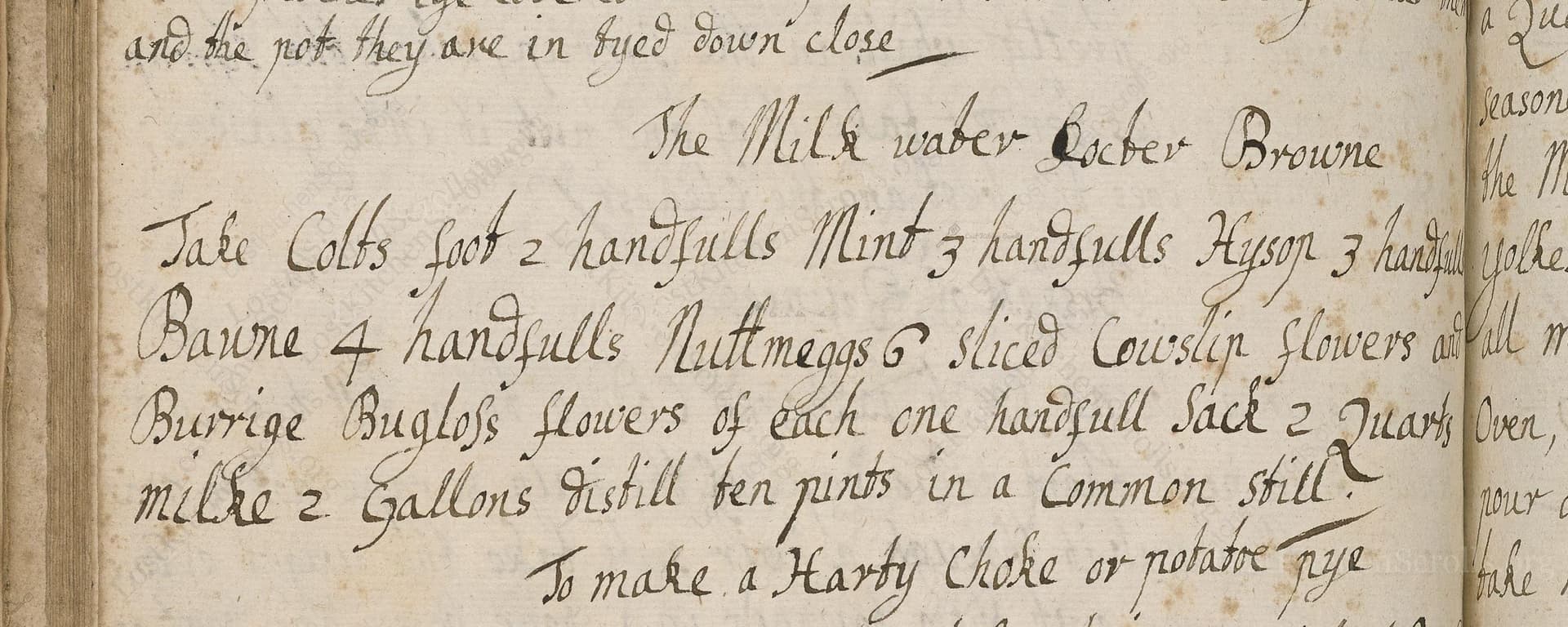The Milk Water Lober Browne
From the treasured pages of Receipt book
Unknown Author

The Milk Water Lober Browne
"Take Colts foot 2 handfulls Mints 3 handfulls Hysop 3 handfulls Bawne 4 handfulls Burrige Bugloss flowers of each one handfull Sack 2 Quarts Nutmeggs 5 sliced Cowslip flowers and milke 2 Gallons distill ten pints in a Common still"
Note on the Original Text
The recipe is written in abbreviated, almost telegraphic form—a style typical of 17th and 18th-century manuscript and household recipe books, where direct instruction was less common, and quantities were often measured in handfuls or quarts. Spellings like 'bawne' for balm and 'burrige' for borage reflect period orthography and dialect. 'Sack' refers to dry Spanish sherry. Directions rely on familiar household implements and assume knowledge of distillation—a skill held by many housewives and apothecaries of the era. The absence of step-by-step instructions assumes an experienced kitchen reader.

Title
Receipt book (1700)
You can also click the book image above to peruse the original tome
Writer
Unknown
Era
1700
Publisher
Unknown
Background
A delightful glimpse into the kitchens of the early 18th century, this historic culinary manuscript promises a feast of recipes, remedies, and perhaps a pinch of mystery. Expect both practical fare and elegant inspiration for the curious cook.
Kindly made available by
Folger Shakespeare Library
This recipe dates to around 1700, a period when distilling floral and herbal waters was common in both domestic medicine and refined household kitchens. The 'Lober Browne' is likely an aromatic medicinal or restorative 'milk water,' valued for its gentle herbs like cowslip, borage, and balm, associated with calming and restorative properties, and was probably consumed as a cordial or tonic. Such recipes stem from a transitional era—late Stuart and early Georgian England—where folk remedies met increasing scientific curiosity, and country households often maintained their own still rooms for making distilled waters, cordials, and medicines.

Back in 1700, this recipe would have been prepared using a 'common still,' typically a copper alembic or simple pot still, heated over a hearth fire. Herbs and liquids were placed in the body of the still, liquid was gently heated, and the resultant aromatic vapor was condensed and collected in a receiving vessel. The process required careful tending for even heating and safe condensation. Tools would also include a large earthenware or copper pot for mixing, sharp knives for slicing nutmeg, and muslin or cloth for straining the final water.
Prep Time
1 hr
Cook Time
2 hrs
Servings
20
We've done our best to adapt this historical recipe for modern kitchens, but some details may still need refinement. We warmly welcome feedback from fellow cooks and culinary historians — your insights support the entire community!
Ingredients
- Coltsfoot leaves, 1.4 oz (approx. two handfuls)
- Mint leaves, 2.1 oz (approx. three handfuls)
- Hyssop, 2.1 oz (approx. three handfuls; or use dried hyssop if fresh unavailable)
- Balm (lemon balm), 2.8 oz (approx. four handfuls)
- Borage flowers, 0.7 oz (one handful; edible borage flowers can be used)
- Bugloss flowers, 0.7 oz (one handful; if unavailable, substitute with borage)
- Sherry wine (sack), 3½ pints
- Nutmegs, 5 whole, sliced
- Cowslip flowers, 0.7 oz (one handful; or primrose flowers as substitute)
- Whole milk, 14 pints
Instructions
- To make 'Milk Water Lober Browne' as described in the early 18th century, gather two large handfuls (about 1.4 oz) of coltsfoot, three handfuls (2.1 oz) each of mint and hyssop, four handfuls (2.8 oz) of balm (or lemon balm), and one handful (0.7 oz) each of borage and bugloss flowers.
- Add these to 3½ pints of sherry wine and five sliced nutmegs.
- Include one handful (0.7 oz) of cowslip flowers, and finally, add 14 pints of whole milk.
- Combine all ingredients and distill, capturing about 8¾ pints of the aromatic liquid.
- If you don't have an alembic or historical still, you may use a modern kitchen distillation setup, such as a large double boiler with a condensation lid to collect the distillate.
Estimated Calories
10 per serving
Cooking Estimates
Preparing this historic recipe takes about an hour to gather and ready the herbs and flowers. Distilling the mixture takes around two to three hours, depending on your setup. Each serving contains very few calories, since the process leaves almost no fats, sugars, or alcohol in the final drink. This recipe makes about 20 servings of distilled milk water.
As noted above, we have made our best effort to translate and adapt this historical recipe for modern kitchens, taking into account ingredients nowadays, cooking techniques, measurements, and so on. However, historical recipes often contain assumptions that require interpretation.
We'd love for anyone to help improve these adaptations. Community contributions are highly welcome. If you have suggestions, corrections, or cooking tips based on your experience with this recipe, please share them below.
Join the Discussion
Rate This Recipe

Den Bockfisch In Einer Fleisch Suppen Zu Kochen
This recipe hails from a German manuscript cookbook compiled in 1696, a time whe...

Die Grieß Nudlen Zumachen
This recipe comes from a rather mysterious manuscript cookbook, penned anonymous...

Ein Boudain
This recipe comes from an anonymous German-language manuscript cookbook from 169...

Ein Gesaltzen Citroni
This recipe, dating from 1696, comes from an extensive anonymous German cookbook...
Browse our complete collection of time-honored recipes



